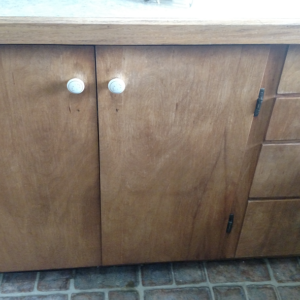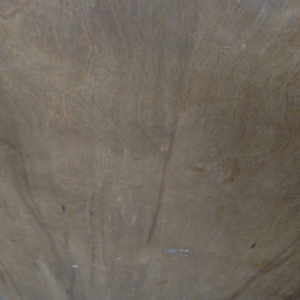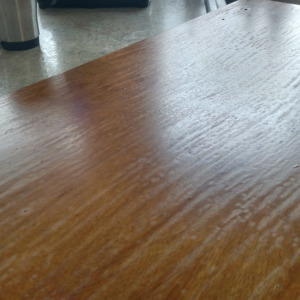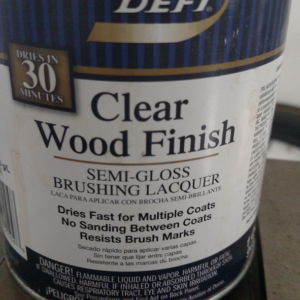Question on finish incompatibility on some wood cabinets
We have a vacation rental house out at the coast. It has a set of stained wood cabinets which are veneered plywood. With the pandemic the rental agent has “enhanced cleaning procedures” going in between stays which basically involves wiping alcohol or disinfectant or bleach or gawd knows what all over every doorknob switchplate handle and everything a person would touch in the place. Anyway this has been particularly hard on the cabinets – whatever they are using is busy dissolving away the finish and has got to the point around the knobs of the cabinets to beginning to bleach the stain right out of the wood.
I decided to try to do some quick repair to the worst of the cabinet doors (the ones with the most damage) I took the doors off, took the handles off, gave the fronts a quick wipe with lacquer thinner and then wiped over some stain that matched the existing stain close enough to get rid of the bleached areas around the handles. I let that sit a few hours then polished it off as best I could with a rag (seeing as how on some of the areas the stain was sitting on top of what was left on the original finish and on others where the finish had been dissolved it had soaked into the wood) Then I covered the doors with brush lacquer.
Apparently the lacquer was NOT compatible with whatever finish had been used previously as you can see by the pic I took of the doors after they had dried overnight.
Now I know that I can just either use stripper or just sand down through the finish and start over, but as I was looking around at the rest of the cabinet doors I realized how bad the rest of the lower cabinets ones are (as you can see in the one picture) so I now want to do all of them.
What I was wondering is if anyone has seen this kind of issue before and might have a guess as to what the cabinet doors were originally finished with. Obviously it was not lacquer. I have used this can of lacquer to finish off stained wood handrails in the house with excellent results and it was almost empty when I tried it on the doors so I’m not worried about buying another can of finish. Nor am I the slightest bit interested in peanut gallery solutions like paint. (painting over nice wood is a crime and those responsible need to be drawn and quartered IMHO) It would be handy to use a finish that would be resistant to whatever they are using to kill COVID as well. Thanks in advance!



















Replies
It might have nothing to do with the prior finish. It could easily have been grease, cleaning solution, bleach, and God know what else was on there. A quick wipe with laquer thinner, as you described it, is not nearly enough prep work before a new finish.
Those are easy to sand, being just flat panels, so it would be easier to take the doors off, sand, and stain and finish. Less work and mess than a truly thorough cleaning, less money, and better results. Just be careful not to sand through the veneer faces.
I agree with you that painting over nice wood is a crime. Fortunately, that isn't nice wood. It's just birch plywood. If that's a rental, and it was mine, I would sand and paint, especially given the continued cleanings it will take. Again, that's what I would do.
Just FYI Lacquer is the last finish you use over an unknown finish its solvents are very strong and will dissolve most other finishes.
By the looks of your cabinets(pictures are poor substitute for insight inspection) I'm guessing they were locally built using birch plywood, probably in the sixties given the construction method, and probably finished with some type of oil based varnish not polyurethane unless they were refinished. That does make it a bit easier to strip the old finish but it's still a major undertaking.
If I'm right about the doors and drawer fronts being birch plywood sanding can be a risky operation since it easy to sand through the face ply even in older plywood which had much thicker face veneers than today's. That leaves chemical strippers as the only way to remove the old finish a very unpleasant task indeed especially if the kitchen is of any size.
My suggestion would be to try clean up the existing finish first, at least until the stringent cleaning regimine is over(I suspect they may be using bleach) , fresh finishes are never fully cured for weeks and would be susceptible to more damage. Remove the knobs and get some 0000 steelwool or white Scotchbrite pads and some oil based wood cleaner and see what happens follow up with a coat of hard paste wax and hopefully the appearance improves.
Fortunately, mounted vertically you can't really tell the finish is doing this particularly since the light in the kitchen is not glaring (of course I deliberately mounted them that way to emphasize the issue) The inside of the house is very very wood - the ceiling is stained wood and beams a high ceiling. Paint would look very out of place. Fortunately the veneer is thick the house was built in 1973. Good point about waiting until the bleach regemin is over. Maybe I'll just wet sand and keep putting poly on it until it's smooth.
I'm not a fan of putting poly over top of old finishes, unlike lacquer poly does not melt into the previous coats but relys an a physical bond with the previous layers. If you keep layering poly on you mind yourself with an insurmountable task when you decide to really tackle the problem.
It’s nitrocellulose finish on top of stain and that brand imho is garbage because I’ve had it so the same
This forum post is now archived. Commenting has been disabled